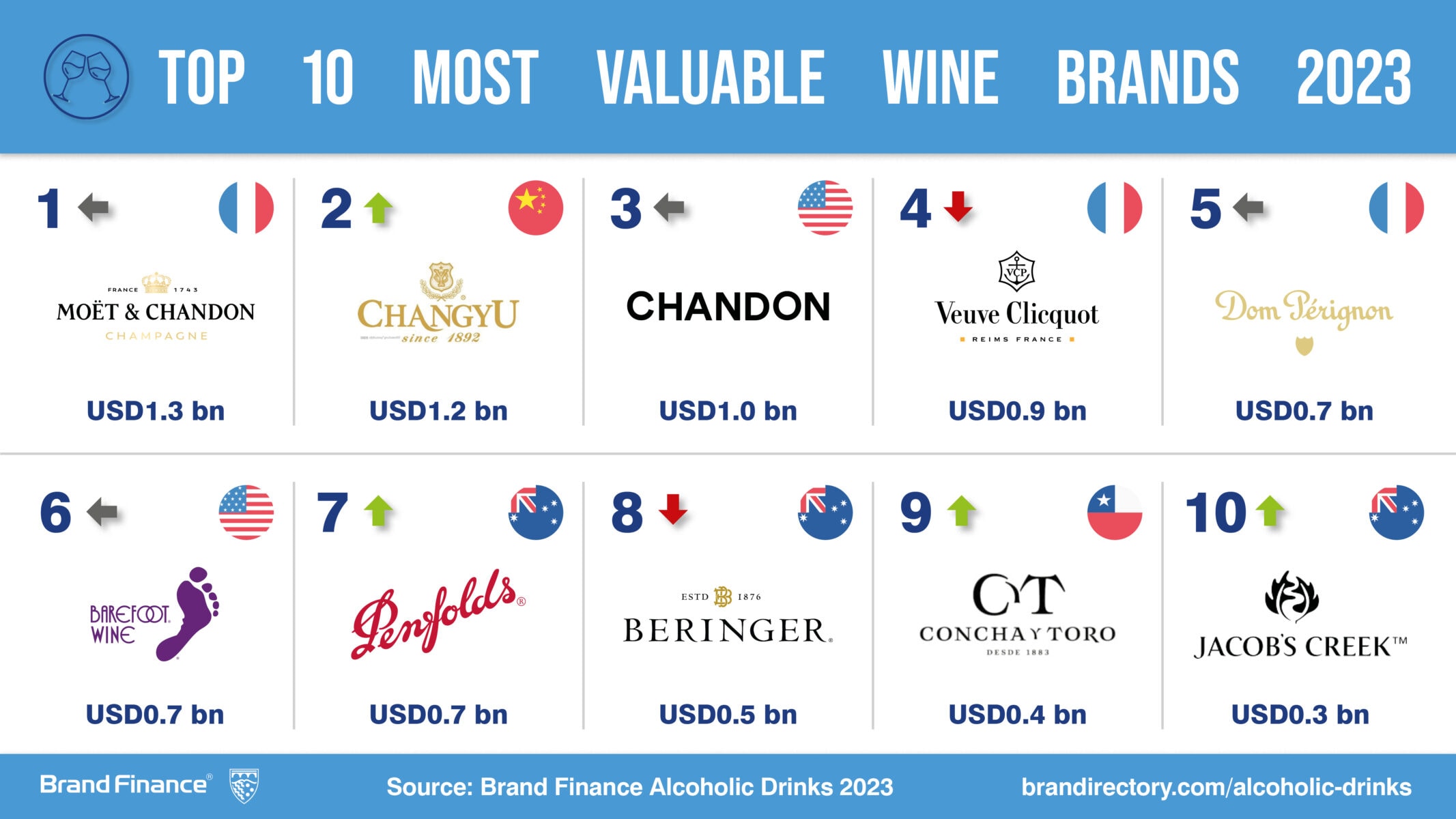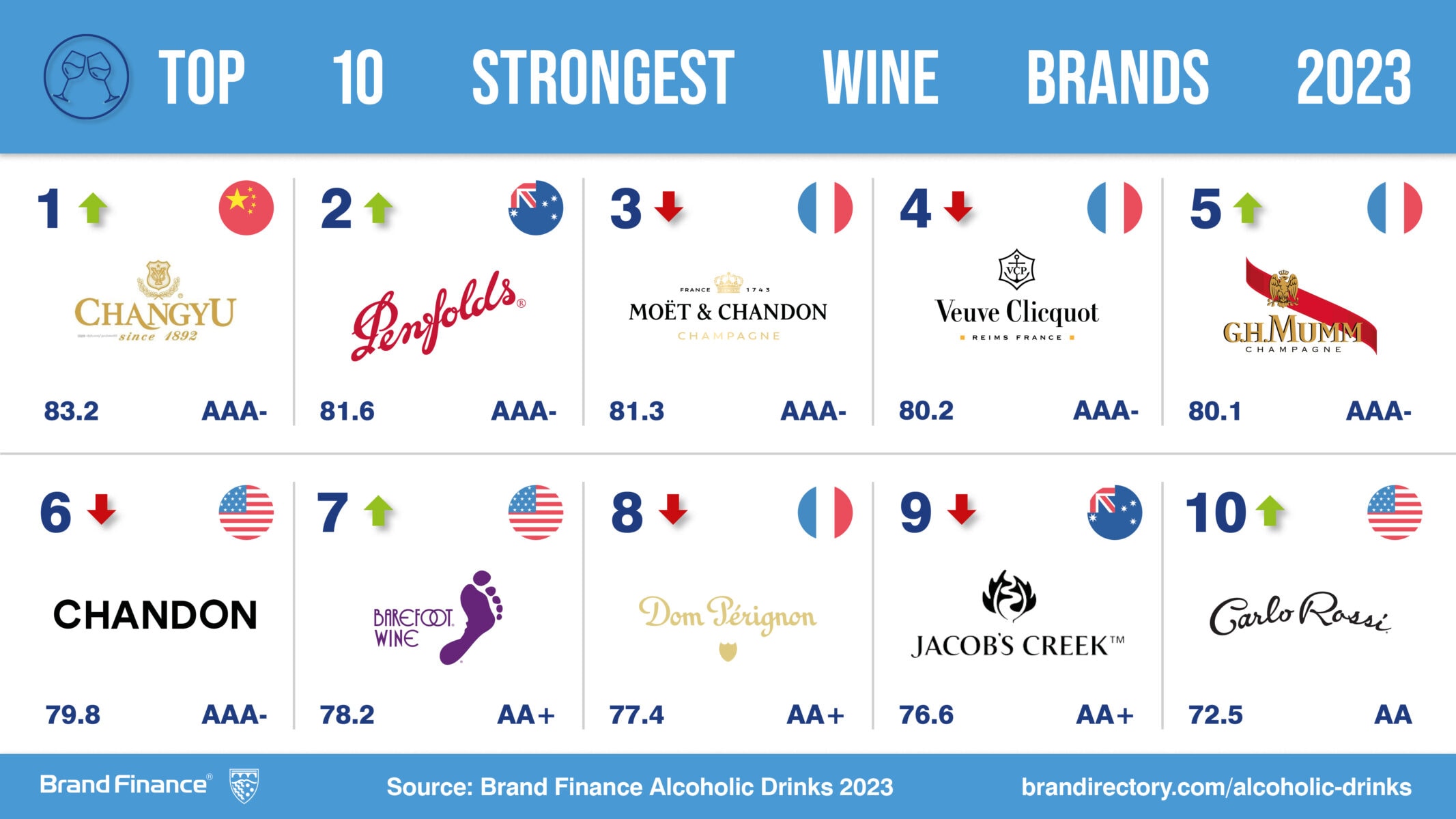View the full Brand Finance Alcoholic Drinks 2023 report here
Moët & Chandon maintains title as most valuable Wine & Champagne brand, valued at USD1.3 billion despite fall in Champagne brand values
Maintaining the number one spot for the third consecutive year, Moët & Chandon (brand value down 10% to USD1.3 billion) tops the ranking as the world’s most valuable wine brand. Despite a slight decline in brand value, the Champagne champion stays just ahead of the ranking’s second most valuable brand Changyu (brand value up 33% to USD1.2 billion), which climbed two positions in this year’s ranking.
Changyu – little known amongst western wine connoisseurs – will be a shock challenger at the top of the wine brand rankings. However, the massive and growing size of the Chinese wine market means that the brand is extremely valuable.Every year, leading brand valuation consultancy Brand Finance puts 5,000 of the biggest brands to the test, and publishes over 100 reports, ranking brands across all sectors and countries. The world’s top 15 most valuable and strongest Champagne & Wine brands are included in the annual Brand Finance Champagne & Wine 15 2023 ranking.
Henry Farr, Associate Director at Brand Finance said:
“Within the Wine & Champagnes sector, Wines have performed better in terms of brand value growth. High-end Champagnes have taken a hit. Difficult growing conditions, reduced availability and price hikes have steered some consumers towards lower-end sparkling wines as an alternative. For those less effected by harsher financial situations, this could be due to not wanting to appear vulgar or ostentatious by indulging in luxury products when others are struggling with the rising costs of living.”

Changyu is the world’s strongest Wine & Champagne brand, rated AAA-
In addition to calculating brand value, Brand Finance also determines the relative strength of brands through a balanced scorecard of metrics evaluating marketing investment, stakeholder equity, and business performance. Compliant with ISO 20671, Brand Finance’s assessment of stakeholder equity incorporates original market research data from over 100,000 respondents in 38 countries and across 31 sectors.
Changyu (up 33% to brand value USD1.2 billion) becomes the strongest Wine & Champagnes brand with a BSI score of 83.2 out of 100, earning it a AAA- rating. The China-based brand boasts three consecutive years of brand strength growth.

Penfolds is the fastest-growing Wine & Champagne brand, up 48%
Penfolds (brand value up 48% to USD659 million) is this year’s fastest-growing Wine & Champagne brand. The Australian-based brand is also the category’s second strongest, with a BSI of 81.6 out of 100. Penfold’s brand strength boasts a 19-point increase since last year and has earned the brand a corresponding AAA- rating.
By embracing new technologies and innovation, Penfolds has streamlined its consumer-centric approach. This includes the brand’s launch of its 2022 wine collection which, for the first time, expanded beyond Australian-made wines. The collection included French and Californian wines as part of the brand’s efforts to enhance global brand awareness and market share, resulting in improved brand value and strength. This has also captured Penfolds’ wider sustainability plan, as the collection aimed to alleviate pressures on regions with harsher climates and reduced crop yields, earning it a Sustainability Perceptions Score of 4.59 out of 10, positioning the brand third in the ranking based on this metric.
View the full Brand Finance Alcoholic Drinks 2023 report here
Brand Finance is the world’s leading brand valuation consultancy. Bridging the gap between marketing and finance, Brand Finance evaluates the strength of brands and quantifies their financial value to help organisations make strategic decisions.
Headquartered in London, Brand Finance operates in over 25 countries. Every year, Brand Finance conducts more than 6,000 brand valuations, supported by original market research, and publishes over 100 reports which rank brands across all sectors and countries.
Brand Finance also operates the Global Brand Equity Monitor, conducting original market research annually on 6,000 brands, surveying more than 175,000 respondents across 41 countries and 31 industry sectors. By combining perceptual data from the Global Brand Equity Monitor with data from its valuation database — the largest brand value database in the world — Brand Finance equips ambitious brand leaders with the data, analytics, and the strategic guidance they need to enhance brand and business value.
In addition to calculating brand value, Brand Finance also determines the relative strength of brands through a balanced scorecard of metrics evaluating marketing investment, stakeholder equity, and business performance, compliant with ISO 20671.
Brand Finance is a regulated accountancy firm and a committed leader in the standardisation of the brand valuation industry. Brand Finance was the first to be certified by independent auditors as compliant with both ISO 10668 and ISO 20671 and has received the official endorsement of the Marketing Accountability Standards Board (MASB) in the United States.
Brand is defined as a marketing-related intangible asset including, but not limited to, names, terms, signs, symbols, logos, and designs, intended to identify goods, services, or entities, creating distinctive images and associations in the minds of stakeholders, thereby generating economic benefits.
Brand strength is the efficacy of a brand’s performance on intangible measures relative to its competitors. Brand Finance evaluates brand strength in a process compliant with ISO 20671, looking at Marketing Investment, Stakeholder Equity, and the impact of those on Business Performance. The data used is derived from Brand Finance’s proprietary market research programme and from publicly available sources.
Each brand is assigned a Brand Strength Index (BSI) score out of 100, which feeds into the brand value calculation. Based on the score, each brand is assigned a corresponding Brand Rating up to AAA+ in a format similar to a credit rating.
Brand Finance calculates the values of brands in its rankings using the Royalty Relief approach – a brand valuation method compliant with the industry standards set in ISO 10668. It involves estimating the likely future revenues that are attributable to a brand by calculating a royalty rate that would be charged for its use, to arrive at a ‘brand value’ understood as a net economic benefit that a brand owner would achieve by licensing the brand in the open market.
The steps in this process are as follows:
1 Calculate brand strength using a balanced scorecard of metrics assessing Marketing Investment, Stakeholder Equity, and Business Performance. Brand strength is expressed as a Brand Strength Index (BSI) score on a scale of 0 to 100.
2 Determine royalty range for each industry, reflecting the importance of brand to purchasing decisions. In luxury, the maximum percentage is high, while in extractive industry, where goods are often commoditised, it is lower. This is done by reviewing comparable licensing agreements sourced from Brand Finance’s extensive database.
3 Calculate royalty rate. The BSI score is applied to the royalty range to arrive at a royalty rate. For example, if the royalty range in a sector is 0-5% and a brand has a BSI score of 80 out of 100, then an appropriate royalty rate for the use of this brand in the given sector will be 4%.
4 Determine brand-specific revenues by estimating a proportion of parent company revenues attributable to a brand.
5 Determine forecast revenues using a function of historic revenues, equity analyst forecasts, and economic growth rates.
6 Apply the royalty rate to the forecast revenues to derive brand revenues.
7 Discount post-tax brand revenues to a net present value which equals the brand value.
Brand Finance has produced this study with an independent and unbiased analysis. The values derived and opinions presented in this study are based on publicly available information and certain assumptions that Brand Finance used where such data was deficient or unclear. Brand Finance accepts no responsibility and will not be liable in the event that the publicly available information relied upon is subsequently found to be inaccurate. The opinions and financial analysis expressed in the study are not to be construed as providing investment or business advice. Brand Finance does not intend the study to be relied upon for any reason and excludes all liability to any body, government, or organisation.
The data presented in this study form part of Brand Finance's proprietary database, are provided for the benefit of the media, and are not to be used in part or in full for any commercial or technical purpose without written permission from Brand Finance.